Before going all-in and purchasing a safety razor, it’s essential to understand the costs associated with one.
You don’t have to go far in popular forums such as Badger & Blade or Reddit’s own /r/wicked_edge before you see men with large, and to be quite honest, expensive, “shave dens.”
These shave dens often include several safety razors, blades from many different brands, brushes, and several shaving creams that total up to several hundred dollars in grooming supplies. One can get easily lost trying to understand if the safety razor is a low-cost shaving option.
If you are considering a safety razor and want to understand the costs associated with owning one, we will cover that below. Besides the ownership costs, we will also review some of the hidden costs (and benefits) of owning a safety razor.
Let’s take a look:
Cost of Ownership of a Safety Razor
Here’s an overview of the ownership cost for the handle and blades of a safety razor system and how it compares to other alternatives in the marketplace:
Handle
When owning a safety razor, the most significant cost will be the price you pay for the razor handle. We looked at 94 popular safety razors, including those from brands like Merkur, Edwin Jagger, Muhle, Feather, Henson, and Parker, and found the average price to be $74 for the handle.
Of course, this is just an average.
Some of the more popular and affordable safety razors include the following:
- Parker 96R ($27)
- Merkur 23C ($30)
- Rockwell 2C ($30)
And some were a bit more pricey:
- Henson Ti22 ($249)
- Rex Supply Co. Ambassador Adjustable Safety Razor ($249)
- Feather AS-D2 ($185)
To put this into context, here’s a chart of the safety razor handle cost compared to cartridge razors, straight razors, shavettes, and electric shavers:
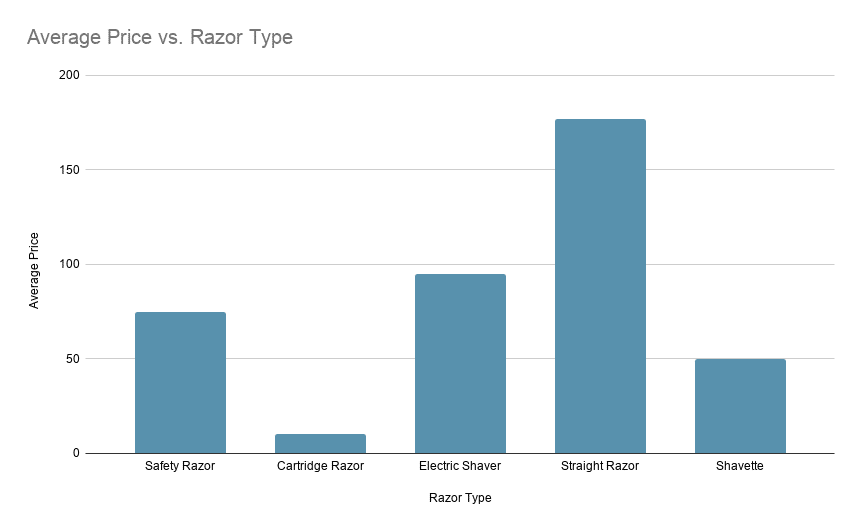
As seen in the chart above, the safety razor handle is significantly more expensive than a cartridge razor and shavette (an injectable straight razor) but cheaper than the electric shaver and straight razor.
However, this chart only tells half the story. The safety razor offers significant savings when it comes to the razor blades.
Razor Blades
Unlike cartridge razors, safety razors offer a universal blade setting. Therefore, you are never locked into using one particular brand. This reduces the long-term cost of ownership. To demonstrate the savings, here’s a chart of how much you should expect to pay for safety razor blades per year:
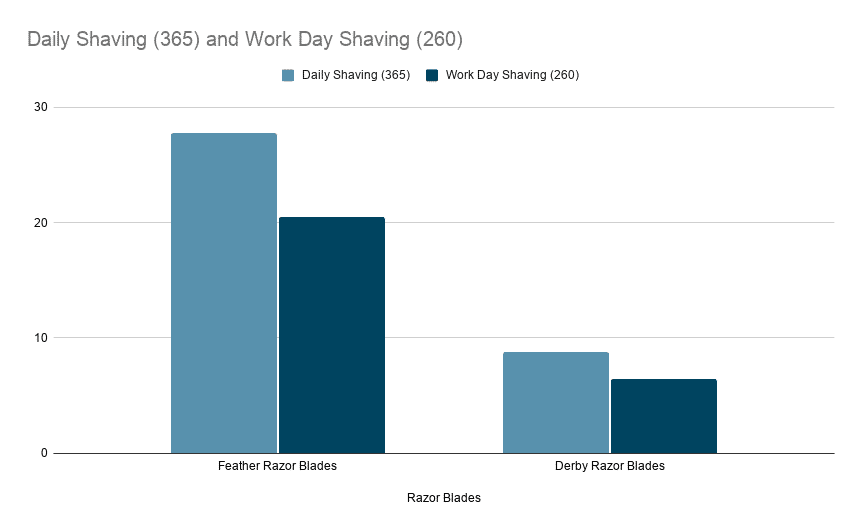
There are a few takeaways from the chart above:
- If you were to shave daily (365 days per year) with Feather razor blades, one of the more expensive razor blade brands, you would only have to pay about $28.
- Should you opt for the more affordable Derby razor blades and still shave daily, the total cost would only be about $9.
Now, of course, shaving 365 times in a given year is unrealistic for most. Should you just shave on working days (5 days a week * 52 weeks = 260), the overall costs are even lower.
The calculation above assumes that you change your blade every five shaves.
For comparison, when considering a cartridge razor system, you can see how much cheaper the razor blades are on an annual basis:
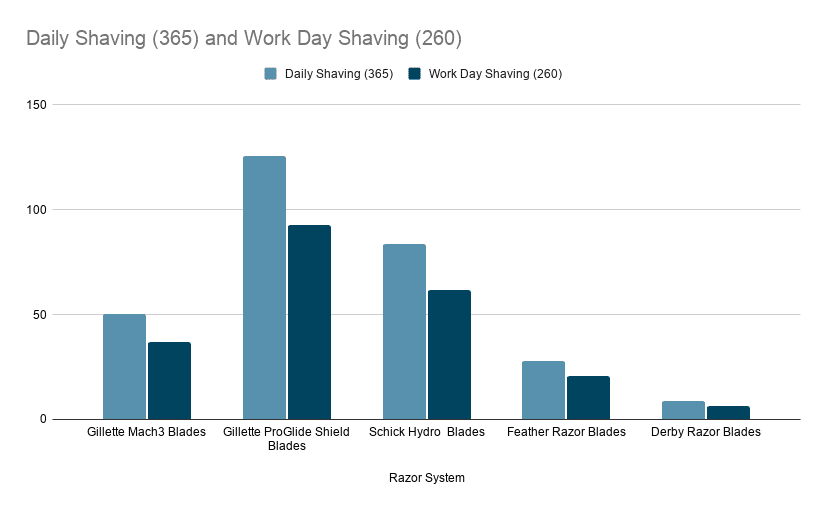
This analysis only looked at two safety razor blade brands. As we recently reviewed, there are several safety razor blade brands available – the above chart provides you with only a representation of expected costs.
Long Term Costs
When buying a safety razor, you aren’t just using it for a single year, here’s how much you can expect to save when using one for five years:
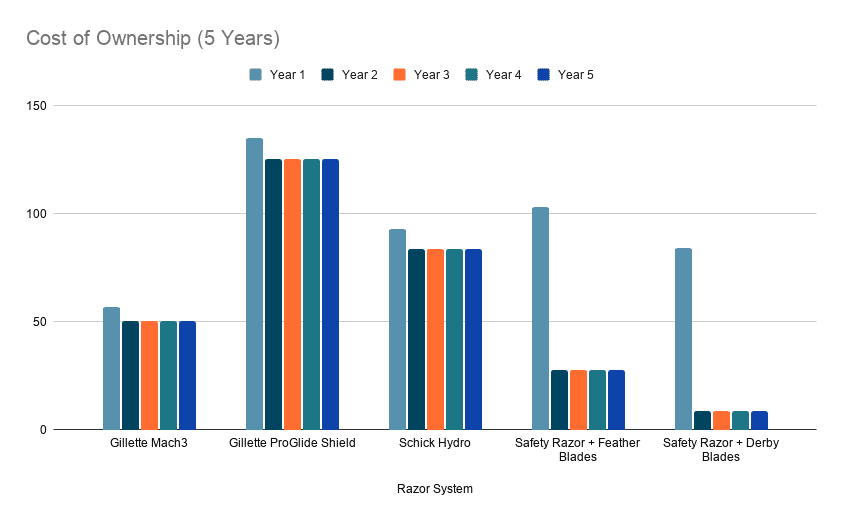
As you can see in the chart above, Year 1 makes the cost of ownership for a safety razor relatively high. However, after the initial investment, the cost of owning a safety razor is significantly lower when compared to other razor systems.
In the chart above, we assumed that the safety razor handle cost $75. Additionally, we assumed that the safety razor blades would be replaced every five shaves, and the cartridge razor blades replaced every 12 shaves. We also assumed 365 shaves per year.
Summary
The initial investment for a safety razor handle is the most significant cost. However, due to the lower cost of razor blade refills, the safety razor will enjoy a lower long-term ownership cost. You will only realize these savings if you are fully committed to using a safety razor for several years.
Hidden Costs
While the costs of owning a safety razor will only be the handle and razor blades, there are additional hidden costs associated with ownership. Let’s explore:
Limited Use
Unlike other razors, the safety razor is a one-trick pony. It is intended for facial hair use only. While some may use it for body grooming, particularly women who shave their legs, the rigid and non-pivoting head limits the mobility of the safety razor.
Therefore, if you shave your head, chest, underarms, or pubic area, you will still need to use a dedicated trimmer or cartridge razor.
Not Travel Friendly
Post 9/11, the safety razor blades are banned from carry-on luggage. Therefore, you will need to either check your bags or buy razor blades when arriving at your destination. Many drugstores carry a limited stock of razor blade brands. However, it is unlikely that you will find your preferred brand. For context, here are the only blades that were in stock at our local Rite-Aid:
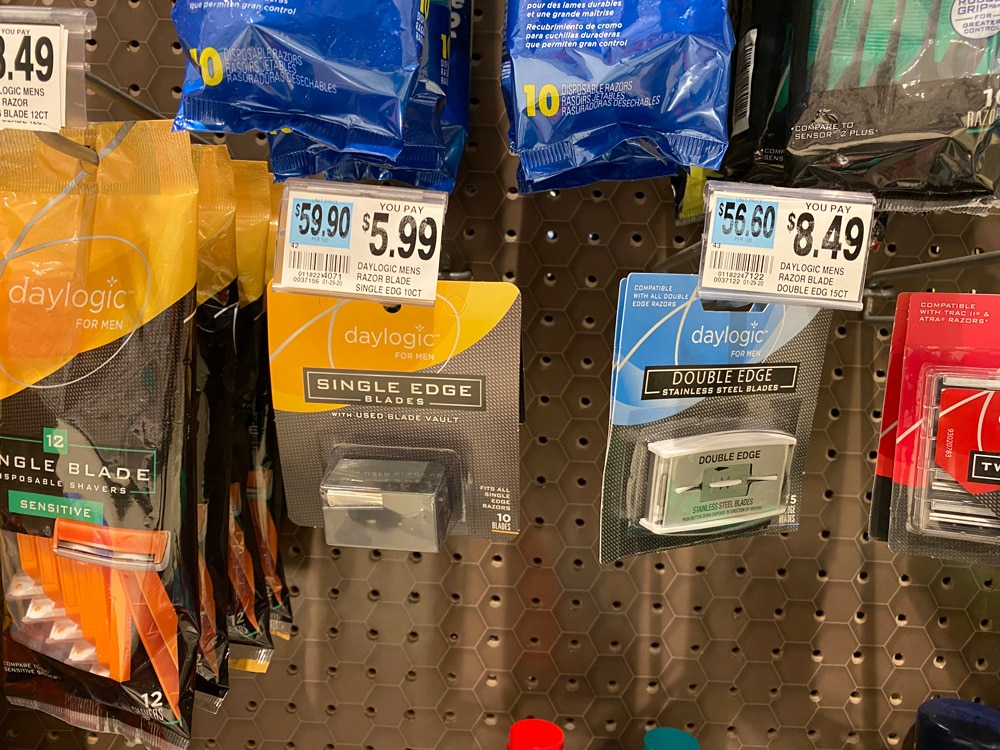
Hotel shops will likely not carry safety razor blades, either. Therefore, you will need to purchase and use a disposable razor upon arrival.
Learning Curve
Learning to use a safety razor takes time. It involves detailed grain mapping and a steady yet confident hand. You may want to pay for some additional shaving supplies such as a styptic pencil or an alum block to stop surface cuts from bleeding too much.
Additionally, if you plan to shave before work in the morning, it will require additional time.
Blade Disposal
Safety razor blades must be disposed of properly. Depending on your local municipality, this may require a trip to a sharps disposal facility. We recommend that you give our blade disposal guide a read for further guidance.
Hidden Savings
Safety razors are becoming increasingly popular for various reasons. Here are some of the hidden savings and benefits of shaving with a safety razor:
Environmental Impact
Crafted from metal, the safety razor is a recyclable and eco-friendly product. Unlike cartridge razors made from a composition of plastic and rubber, the safety razor won’t take several hundred years to decompose.
Replacement Costs
A well-made safety razor can last a lifetime. Even the more affordable options should last you several years before replacement is necessary. There are limited moving parts with the safety razor that reduce any mechanics from degrading over time.
Mental Enjoyment
Many enjoy the mental benefits of using a safety razor. It provides a pleasant barbershop-like experience that can be stress-relieving, especially once you get the hang of it. This is likely why so many people begin to introduce new products to their shave den over time.
Other Costs
Safety razors are often associated with fancy shave creams, shave brushes, and more. These products are not necessary for a safety razor to work. Here are a few things you should know:
- Shaving Cream: A well-made shaving cream will retain heat and moisture while also providing a lubricated cushion. These properties increase the comfort of the shave. Regardless of a safety razor or cartridge, always invest in good shaving cream.
- Shaving Brush: A shaving brush provides a gentle exfoliation that loosens dead skin and oils trapped deep in the pores. Additionally, a shave brush can help to generate a better lather with shaving cream. They come in many different types; read our shaving brush guide if you want to learn more.
- Shaving Stand: A shaving stand provides a sanitary way to store your razor and brush. Consider this only if you plan on using a shaving brush or like to have your countertop organized.
We hope that this guide helped identify all the costs and benefits associated with owning a safety razor.